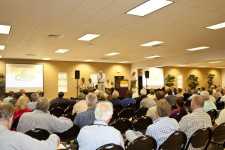2013 Florida Citrus Show Primer

HLB is still rampant; battles against blight and black spot rage on; and canker continues to be a concern. Despite the negative forces at play surrounding the state’s citrus groves, the economic driver that is the Florida citrus industry chugs onward. The forward momentum can be directly attributed to not only the desire of vested growers to stay in business, but also the army of researchers dedicated to seeing citrus succeed into the years ahead. The 2013 Florida Citrus Show, scheduled for Jan. 23-24 at the Havert L. Fenn Center in Ft. Pierce, promises to put the spotlight on this team effort.
The annual short course/trade show — presented in partnership by Florida Grower, the Indian River Citrus League, and UF/IFAS — has established itself over the years as a must-attend event, growing out of its Indian River Citrus Seminar roots. Along with changes that occur with anything sporting longevity, the main theme of bringing together growers, packers, and other industry professionals to vet all available knowledge to help make savvy management decisions remains. Tim Gaver, St. Lucie County citrus Extension agent, says this year’s agenda is packed with intel designed to help a grower stay ahead of the curve. These sessions include the latest on psyllid management, foliar nutrition therapy, canker management, new varieties, and more. In addition, there are several researchers on the docket who will provide some optimism on what is happening in our rootstock and scion breeding programs. When asked if he could single out a program highlight, Gaver says take your pick. “We would all like to hear a presentation that divulges the ‘silver bullet’ solution for our production issues,” he says. “We don’t have that presentation on the program, but we do have a number of presentations that offer information that will help a grower stay in business in what we hope is the interim.”
Though HLB continues its dominance as the main topic of interest, Gaver says there are other issues causing concern for the state’s producers. “Fresh grapefruit growers are facing a situation where they have to maintain market share with an aging infrastructure,” he says. “That is, aging grapefruit trees with HLB and canker that produce lower per acre yields and require expensive production programs to produce high-quality fruit. The answer is to plant new trees and the associated challenge is to grow those trees into production while battling HLB and citrus canker.”
Barrett Gruber, UF/IFAS citrus horticulturist and Citrus Show program planning member, says the big picture facing Florida growers, beyond HLB, was taken into consideration when creating this year’s agenda. “There are other specific diseases posing threats to Florida citrus production as well,” he says. “We wanted this year’s Show to include updates on canker and black spot management, too. In a general sense, we hope the Show will provide information on how to bring young trees into production quickly and how to maintain the productivity of established, bearing trees.”
While the angst continues over pest and disease pressure, T.P. Kennedy, new president of the Indian River Citrus League, says the overall mood of growers on the Indian River is optimistic due to the strength of the grapefruit market in general. “The overall quality is good and the crop appears to be extremely manageable and should last with some breaks from the weather well into May,” he says.
All part of the territory, Kennedy agrees that there is no shortage of challenges ahead, but maintains HLB and canker are still the frontline priority items, especially for growers on the River. “The growers are anxious for research to turn the corner on canker and HLB,” he says.
Anyone who has attended the Florida Citrus Show in the past will tell you education is the main focus in the session room, but that there also is plenty to see and learn about on the tradeshow floor. Nearly 90 industry suppliers will set up displays featuring the latest products and services. Among the displays will be samples of new citrus varieties from UF/IFAS and USDA to see and taste. Similar to last year’s new addition, large pieces of equipment not only will be part of the viewing experience outside the facility, but also inside.
Building off of last year’s record-breaking attendance, Florida Grower publisher Gerry Bogdon says he expects another great turnout for the 2013 rendition. “The Florida Citrus Show kicks off the new year. I can’t think of better way to do that than by meeting, networking with, and learning from peers.”
To see the complete schedule of events, and to register for the Show, go to CitrusShow.com.









